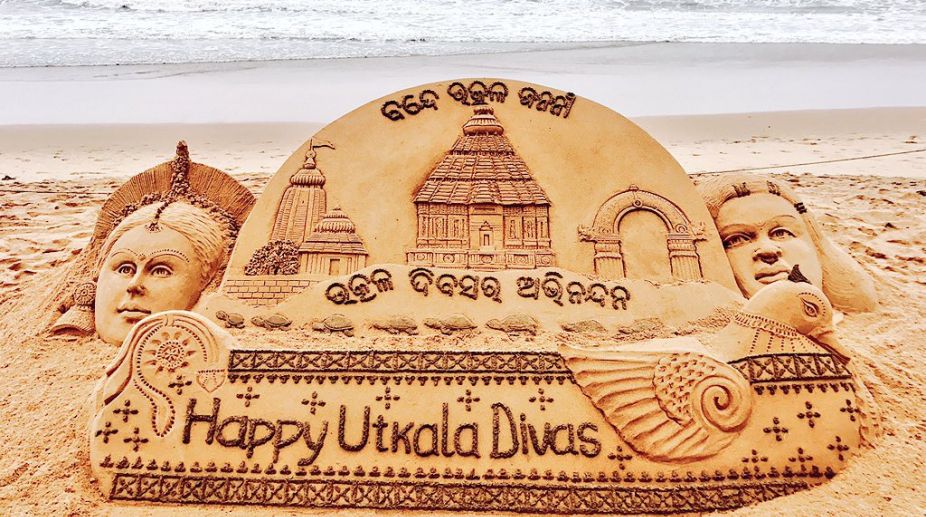Pursue career with mother language-based education: Odisha CM to tribal students
Naveen Patnaik was addressing a gathering at the state-level felicitation ceremony of Zonal Sargiful-2023 winners at the Lokseva Bhawan in Bhubaneswar.
Odisha became a separate province on April 1, 1936. Earlier, it was part of Bengal Presidency

Sudarsan Pattnaik's sand art at Puri beach on the occasion of Utkala Dibasa. (Photo: @sudarsansand on Twitter)
On April 1, 1936, Odisha became a separate province, after a long struggle of over three centuries. The formation of Orissa province under the British rule, separated from Bengal and Bihar, marked the beginning of a new journey for the state. Odisha Day, also known as Utkal Divas and Utkala Dibasa, is celebrated on April 1 every year in memory of all the struggle that went into gaining a separate political identity for the state that was once part of Kalinga ruled by emperor Ashok, and later by Kharavela, remembered as a conqueror and the champion of Jainism, before Mughals invaded and wrested it.
There is a restricted holiday on the day in the state. Odisha Day is also called Orissa Foundation Day and Vishuva Milan.
Prime Minister Narendra Modi, Chief Minister Naveen Patnaik, BJP president Amit Shah and MP Baijayant Jay Panda were among the political leaders who wished the state on the occasion.
Advertisement
Best wishes to my sisters and brothers of Odisha on Utkala Dibasa. pic.twitter.com/mspuBqMYQW
— Narendra Modi (@narendramodi) April 1, 2018
ଓଡ଼ିଶା ଦିବସରେ ସମସ୍ତଙ୍କୁ ମୋର ହାର୍ଦ୍ଦିକ ଅଭିନନ୍ଦନ। ସ୍ଵତନ୍ତ୍ର ପ୍ରଦେଶ ଗଠନର ମନୀଷୀମାନଙ୍କୁ ମୋର ବିନମ୍ର ଶ୍ରଦ୍ଧାଞ୍ଜଳି। ଓଡ଼ିଆ ଭାଷା, ସଂସ୍କୃତି ଓ ଐତିହ୍ୟକୁ ବିଶ୍ଵବ୍ୟାପୀ କରିବା ସହ ସବୁ କ୍ଷେତ୍ରର ଜନସାଧାରଣଙ୍କ ସର୍ବାଙ୍ଗୀନ ଉନ୍ନତି କରି ଓଡ଼ିଶାକୁ ଦେଶର ଶ୍ରେଷ୍ଠ ରାଜ୍ୟରେ ପରିଣତ କରିବା ଆମ ସଂକଳ୍ପ।
ବନ୍ଦେ ଉତ୍କଳ ଜନନୀ। pic.twitter.com/r910zKdXzl— Naveen Patnaik (@Naveen_Odisha) April 1, 2018
On #UtkalaDibasa, I extend my warm greetings to our sisters and brothers of Odisha. May the land of Mahaprabhu Jagannath scale new heights of progress and development in the years to come.
— Amit Shah (@AmitShah) April 1, 2018
On this #UtkalaDibasa let us remember those proud Odias who in the late 19th & early 20th century rescued a grand old people & our language from dereliction, & realised in 1936 the modern state of Odisha by reuniting most of our territories, scattered among various Presidencies🙏
— Baijayant Jay Panda (@PandaJay) April 1, 2018
Panda attended an event in Singapore on the eve of Odisha Day. In a tweet, he said: “It’s a pleasure to be part of this year’s annual event of the Odisha Society of Singapore, a day ahead of #UtkalDibasa (Odisha day). Glad to see Prabasi Odias in successful, high profile professions. My dream is for Odisha to have the environment for them to succeed at home.”
It’s a pleasure to be part of this year’s annual event of the Odisha Society of Singapore, a day ahead of #UtkalDibasa (Odisha day). Glad to see Prabasi Odias in successful, high profile professions. My dream is for Odisha to have the environment for them to succeed at home🙏🏽 pic.twitter.com/tGsa5iM92Z
— Baijayant Jay Panda (@PandaJay) March 31, 2018
Famous sand artist Sudarsan Pattnaik celebrated the day in his signature style and posted a photo of his sand art on Utkala Dibasa on Twitter. He wrote: ”Greetings on the occasion of #UtkalaDibasa . My SandArt at Puri beach in Odisha. #BandeUtkalJanani.”
Greetings on the occasion of #UtkalaDibasa . My SandArt at Puri beach in Odisha. #BandeUtkalJanani. pic.twitter.com/GcI09BUlDt
— Sudarsan Pattnaik (@sudarsansand) April 1, 2018
Utkala Dibasa: History and significance
According to historians, Orissa was originally inhabited by tribes that lived in its hills and plains. Later, it became part of Kalinga, the ancient kingdom that Magadh king Ashok invaded in 261 BC to expand Mauryan rule. The ‘Great Kalinga War’ famous for the bloodblath it saw was eventually won by Ashok, though he could not enjoy his victory and soon embraced Buddhism.
Apart from the Great Kalinga War, recorded history had few references of the kingdom until king Kharavela’s rule began. In fact, Kalinga under Kharavela had managed to avenge the Maurya invasion by defeating Magadh. Historians say Kharavela, besides being known for establishing Kalinga as a mighty political state of India, is also credited with laying the foundation for Orissa’s fame as a land of art, architecture and sculpture.
Gajapati Mukunda Deva was the last Hindu king of Odisha, who was defeated by the Mughals in 1576. In 1803, the British took over the reins of the state, dividing it into several administrative units. The northern and western districts became part of Bengal Presidency. Later, the coastal region was made into the Province of Bihar and Orissa.
Finally, with the efforts of Oriya leaders in uniting the Oriya-speaking people succeeding, the new political province of Orissa was formed on April 1, 1936. Sir Jhon Austin Hubbak became the first governor.
Once India got its Independence, the area under Orissa almost doubled, and it became a constituent state in the Union of India in 1950.
The state’s name was changed from Orissa to Odisha on 24 March, 2011, after Rajya Sabha, the upper house of Parliament, gave its nod to the Orissa (Alteration of Name) Bill, 2010 and the Constitution (113th Amendment) Bill. The Lok Sabha, the lower house, had passed the bill and the amendment to change the name of the state from Orissa to Odisha, and that of its language from Oriya to Odia, on November 9, 2010.
Advertisement